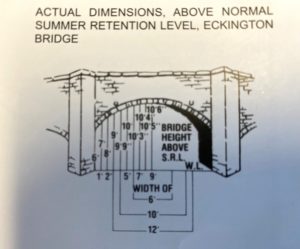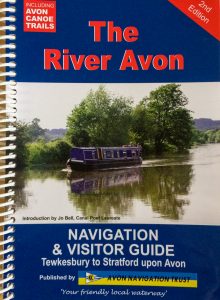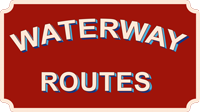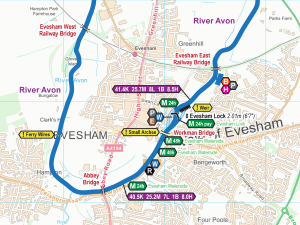General Information
Maximum Recommended Craft Dimensions
Stated maximum draught is for vessels with protected sterngear. Note that minimum headroom is at normal river levels, and can be lower during periods following heavy rain.
| |
Lower Avon |
Upper Avon |
| Length |
70ft |
(21.3m) |
70ft |
(21.3m) |
| Beam |
13ft 6in |
(4.1m) |
12ft 9in |
(3.89m) |
| Draught |
4ft |
(1.2m) |
3ft |
(0.9m) |
| Headroom |
10ft |
(3.0m) |
8ft |
(2.4m) |

King Johns Bridge can be used as a gauge for headroom on the Avon from Tewkesbury to Evesham. Click here to see large diagram

Eckington Bridge Headroom and Width
River Levels and Gauges
Unlike a canal, the water in a river is continually flowing, and its rate of flow and level varies. After heavy rain in the catchment area, levels can rise, and/or the rate of flow increase to a point where navigation can be hazardous.
The Trust has installed water level gauges at every lock designed to indicate the water level in each stretch of the river and help you gauge whether it is safe to proceed. Check the water level against the colours on the gauge, and compare it with the advice on the sign.
RED Danger – stop and moor your boat.
ORANGE Increased current, proceed with caution.
GREEN Normal navigable level.
The Trust has also set up River Watch, which is a network of web cams and links to the EA river gauges that can be viewed through our web site on your PC or smart phone. Please view this on our River Watch Page.
Locks
There are 17 locks on the 47 miles of the Avon between Tewkesbury and Stratford.
Locks on the Avon are manually operated by boaters, and the paddle gear on the locks accept the small 1in taper (or the ‘Northwich’ type lock key) on your windlass.
The exception is Avon lock at Tewkesbury, which is manned by a lock keeper.
Avon Lock – Lock keeper’s hours for 2024 are:
1st January to Friday 15th March 2024: Booked passage only
Saturday 16th March to Sunday 3rd November 2024: 8:00am to 18:00
Monday 4th November 2024 to Friday 14th March 2025: Booked passage only
(lunch break: 1300 – 1400. Last Locking 1pm)
Operating Locks Winter – Avon Lock at Tewkesbury is un-manned and bookings for an out of season locking can be requested by calling the office on 01386 552517 or 0300 111 2010 – 48 hour prior to passage.
If you have not operated locks before, don’t worry. Take your time, and if you are unsure ask another boater – they will be happy to help. Passing through locks in company eases the load, and allows you to chat to other people on the river.
When locking up to a higher level, secure lines at bow and stern but be prepared to take in the slack as the boat rises, inside the lock with both bow and stern lines, close the gates and check their paddles are lowered, or closed. Go to the top gates and operate the rack gearing to raise the paddles. Open them a little way at first and pause; the turbulence from too much water entering the chamber can force boats off the lock side, or make them surge up and down and hit the gates. Once the water level has risen a little, and crews have shortened in their lines, open the paddles some more, check all is safe and then you should be able to open them up fully. Leave the gates OPEN when you leave, and all paddles CLOSED. When closing the paddles, please wind them down slowly; pushing down the rack with your hand causes shock loading and can damage the gear and equipment.
When locking to a lower level, the procedure is the same, except for the following. Boat crews MUST NOT make fast their lines, but should pay them out by hand as the water level in the lock drops. Vessel’s should KEEP CLEAR of the cill below the top gates to avoid being caught up on their sterngear. Operators of the paddles on the bottom gates should be vigilant, and close them immediately if a vessel gets into difficulties.
** Please use both a bow and stern line at all times. Centre lines are not acceptable on the river. **
Rights of Way
In common with maritime convention, the rule is to pass port to port (meaning you should ‘drive on the right’ or alter course to starboard to pass another boat). You should give way to commercial, cargo carrying vessels and maintenance craft, and they should be given priority at locks. If your vessel is large or difficult to manoeuvre, please give one long blast on your horn when negotiating a sharp or blind bend in the river to warn other river users you are approaching.
Speed
The maximum speed limit on the Avon is: maximum speed limit is 4mph upstream and 6mph downstream (measured over the river bed). Please slow down when approaching bridges, locks, blind corners, and narrow sections of the river, or when passing moored craft.
Wash
The wash produced by a boat not only depends upon it’s speed, but also it’s hull form and how it is laden. Excessive wash from boats damages and erodes the riverbank. If your vessel is producing a large wash, please slow down. Please always slow down when passing moored boats or other river users.








